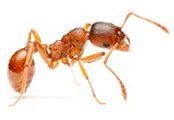How Did The Non-Native Pavement Ant Arrive In The US Where It Is Now The Most Common Ant Pest?
The three most common ant pests in the northeastern United States are commonly known carpenter ants, odorous house ants, and pavement ants. Carpenter ants are easily recognizable for being noticeably large in body size, even for ants, and odorous house ants have become well known for the unpleasant odor they emit when disturbed. Pavement ants are probably the most frequently encountered ants in the country, as these are the ants that most people see skittering about on sidewalks, driveways, and other paved surfaces. Despite their ubiquity throughout the US, pavement ants are not actually native to the country, as they were inadvertently transported into the US from Europe during the 1700s.
Like most ant species, pavement ants (Tetramorium caespitum) are soil-nesting ants, and experts believe that they were inadvertently transported into the US within large amounts of soil that were loaded onto European ships to provide ballast before departing across the Atlantic. Once these ships arrived at the northeastern coast, the soil was removed and replaced with goods bound for Europe. Today, pavement ants can be found in most US states, and according to a recent nationwide survey of pest control professionals, the pavement ant is the second most commonly controlled ant pest in the country, but they remain most abundant in the northeast.
Pavement ants are relatively small, as the brown to black workers are between 2.5 and 4 mm in length, and they form small nesting mounds in yard soil. Workers of this species frequently enter homes from outdoor nests to seek food sources, and they will readily feed on any food crumb that falls to the ground, including sweets, meats, greasy foods, fruits, and seeds. Workers frequently enter homes through cracks in concrete and masonry foundations, but they often establish multiple secondary nests within concealed areas like wall voids, ceiling voids, and beneath floorboards. Since pavement ant workers secrete trail pheromones while foraging, patiently following workers back to their nest will reveal the location of their nesting sites, all of which must be destroyed to end an infestation. Several baiting systems effectively control pavement ants, and pest control professionals can apply a perimeter barrier around homes to deny workers indoor access.
Have you ever used baits to control an ant infestation?


Comments are closed.